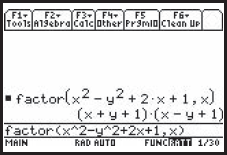11.4. Other Factorable Expressions
11.4.1. More Factoring by Grouping
We have used the grouping method to factor trinomials. Now we extend it to expressions containing four terms. Here we try to arrange terms into smaller groups of two, each of which has a common factor. We will show the method by examples.
Example 25:Factor ab + 4a + 3b + 12. Solution: Group the two terms containing the factor a, and group the two containing the factor 3. Remove the common factor from each pair of terms.
Both terms now have the common factor (b + 4), which we factor out, getting
|
Example 26:Factor x2 − y2 + 2x + 1. Solution: Taking our cue from Example 25, we try grouping the x terms together.
But we are no better off than before. We then might notice that if the +1 term were grouped with the x terms, we would get a trinomial that could be factored. Thus
or
We now have the difference of two squares. Factoring again gives
|

TI-89 calculator solution for Example 26.
11.4.2. Sum or Difference of Two Cubes
An expression such as
- x3 + 27
is called the sum of two cubes (x3 and 33). In general, when we multiply the binomial (a + b) and the trinomial (a2 − ab + b2), we obtain
All but the cubed terms drop out, leaving the sum of two cubes.
Get Technical Mathematics, Sixth Edition now with the O’Reilly learning platform.
O’Reilly members experience books, live events, courses curated by job role, and more from O’Reilly and nearly 200 top publishers.

